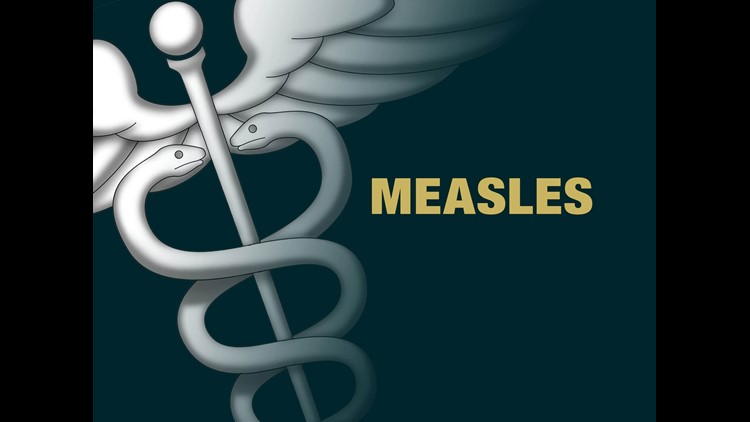(Press Release) - What is Measles?
Measles is an infectious, viral respiratory disease caused by the measles virus.
Measles is highly contagious and is spread easily. The measles virus resides in the mucus in the nose and throat of infected people. When they sneeze or cough, droplets spray into the air and the droplets remain active and contagious on infected surfaces for up to 2 hours. Infected people are usually contagious from about 4 days before their rash starts to 4 days afterwards. Thus, an infected person can spread the disease before knowing he or she is infected.
Measles symptoms begin with fever, runny nose, cough, loss of appetite, and red, watery eyes for about four days, followed by a rash. The rash usually lasts 5-6 days and begins at the hairline, moves to the face and upper neck, and proceeds down the body.
The disease can also cause severe illness and complications, such as diarrhea, ear infections, pneumonia, encephalitis (brain infection), seizures, and death. These complications are more common among children under 5 years of age and adults over 20 years of age.
It takes an average of 10-12 days from exposure to the first symptom, which is usually fever. The measles rash does not usually appear until approximately 14 days after exposure, 2-3 days after the fever begins.
Measles is diagnosed by a combination of the patient's symptoms and by laboratory tests.
There is no specific treatment for measles. People with measles need bed rest, fluids, and control of fever. Patients with complications may need treatment specific to their problem.
No.
Measles is a common disease in many countries throughout the world. It is possible that people from other countries who visit the United States could be ill with the measles. To prevent getting measles from overseas visitors and to prevent getting measles when traveling internationally, U.S. residents should make sure they have been appropriately vaccinated. Before any international travel, infants 6 months through 11 months of age should have one dose of measles vaccine; children 12 months of age or older should have two doses separated by at least 28 days; and adolescents and adults who have not had measles or been vaccinated should get two doses separated by at least 28 days.
The best protection against measles for individuals and the community is through routine immunization with MMR vaccine. This is a combined vaccine that protects against measles, mumps and rubella.
In almost all cases, people who received the MMR vaccine are protected against measles. However, in rare cases, people who get the vaccine can still become infected with the measles if exposed to the virus. Two doses of MMR vaccine provide full protection against measles to 99 out of every 100 persons vaccinated.
Children should receive the first dose of MMR vaccine at 12-15 months of age and the second dose at 4-6 years of age (or no earlier than 28 days after the first dose). Older children who have not been vaccinated should receive two doses of MMR vaccine at least 28 days apart. The recommended age for receiving MMR vaccine might change if there is a measles outbreak in your community, or if you will be traveling to a foreign country. In such cases, check with your child's health care provider to ensure that your child is properly vaccinated to protect against measles. Additional information about MMR vaccination can be found on the CDC website here.
Do adults need to be vaccinated against measles?
All U.S. adults born during or after 1957 should also get at least one dose of MMR vaccine unless they can show they have either the vaccine or had a blood test that showed they were immune to measles. Healthcare workers should have two doses of MMR vaccine. More specific recommendations for vaccinating adults can be found on the Centers for Disease Control and Prevention (CDC) website here.
Are there people who should not get the MMR vaccine?
Yes, some people should not get MMR vaccine or should wait before getting it. This includes persons with allergies to components of the vaccine and those with medical conditions that preclude vaccination. If you have further questions, discuss them with your health care provider. Additional information can be found on the Vaccine Information Statement (VIS) found on the CDC website here.
Is the MMR vaccine safe?
The MMR vaccine has been in use for more than three decades in the U.S., and reports of serious adverse events following vaccination have been extremely rare. As with all vaccines, there can be minor reactions from the MMR vaccine. These reactions might include pain and redness at the injection site, headache, fatigue, rash, or a vague feeling of discomfort.
It is important to know that the risk of MMR vaccine causing serious harm or death has been extremely small and that being vaccinated is much safer than getting any of the three diseases (measles, mumps and rubella) the vaccine protects against.
Vaccine safety experts, including experts at CDC and the American Academy of Pediatrics (AAP), agree that MMR vaccine is not responsible for recent increases in the number of children with autism. In 2004, a report by the Institute of Medicine (IOM) concluded that there is no link between autism and MMR vaccine, and that there is no link between autism and vaccines that contain thimerosal as a preservative.



